
Go Fiber and Gin are two popular web application frameworks that rely on Go’s standard library. They provide extensive toolkits we can use to develop high-performance apps with modern features.

While both frameworks share the same goal of providing an efficient and simplified development experience, they have distinct design philosophies and features. Let’s look at each framework’s qualities and strengths and compare them to help you choose which is best for your project.
The Replay is a weekly newsletter for dev and engineering leaders.
Delivered once a week, it's your curated guide to the most important conversations around frontend dev, emerging AI tools, and the state of modern software.
Fiber is a modern framework in Go. It’s built on top of fasthttp, which is Go’s fastest HTTP engine. You can create high-performance web applications easily with Fiber, as it facilitates rapid development with zero memory allocation, performance, and efficiency in mind.
Fiber’s lightweight and modular design makes it an ideal choice for developing microservices and high-performance web apps.
Below are some of the standout features of Fiber you should know:
It’s also worth noting that Fiber is inspired by Express.js framework. In fact, one of Fiber’s key strengths is its similarity to the Express.js API and middleware system, which makes it easy to transition between the two frameworks.
The table below shows the relationship between Fiber and Express, including their similarities and differences:
| Fiber | Express | |
|---|---|---|
| Performance | Generally faster due to Go’s efficiency and fasthttp engine | Highly performant but slower compared to Fiber in certain benchmarks |
| API style | Inspired by Express.js, aiming for familiarity for JavaScript developers transitioning to Go | Express.js style, widely adopted in the JavaScript ecosystem |
| Concurrency model | Uses Go’s native concurrency model, allowing efficient handling of concurrent requests | Event-driven, single-threaded model, leveraging Node.js’ event loop |
| Usecase | Ideal for developers looking to transition from JavaScript to Go or for high-performance applications | The best choice for JavaScript developers on the backend |
| Routing | Inspired by Express.js, supports dynamic routing, route parameters, and nested routes | Supports dynamic routing, route parameters, and nested routes |
| Error handling | Built-in support for error handling, including custom error pages and error handlers | Built-in support for error handling, including custom error pages and error handlers |
| Middleware | Supports the concept of middleware, where functions are executed sequentially in the order they are defined | Also supports the concept of middleware, where functions are executed sequentially in the order they are defined |
Open up the terminal and navigate to the folder for this project. Initialize a module for this project:
go mod init fiber_demo
Install Fiber into your project using the go get command:
go get github.com/gofiber/fiber/v2
This command installs the gofiber package and its necessary dependencies.
We’ll create a basic application that responds with a “Hello World!” to Get requests using Fiber. Create a file called main.go inside your project directory and add the following code:
package main
import (
"github.com/gofiber/fiber/v2"
)
func main() {
app := fiber.New()
app.Get("/", func(c *fiber.Ctx) error {
return c.SendString("Hello, World!")
})
app.Get("/greet/:name", func(c *fiber.Ctx) error {
name := c.Params("name")
return c.SendString("Hello, " + name + "!")
})
app.Post("/submit", func(c *fiber.Ctx) error {
type Request struct {
Name string `json:"name"`
Email string `json:"email"`
}
var req Request
if err := c.BodyParser(&req); err != nil {
return c.Status(fiber.StatusUnprocessableEntity).JSON(fiber.Map{
"error": "Cannot parse JSON",
"details": err.Error(),
})
}
return c.JSON(fiber.Map{
"message": "Data received",
"name": req.Name,
"email": req.Email,
})
})
app.Listen(":3000")
}
In the code above, we define a sole route for GET requests to the root path "/" using the app.get function. When you access it the server sends back a "Hello,World!" response string.
We also define two other routes. One route is for handling the GET request for /greet/:name. The :name is a dynamic parameter. When we try to access the route, the server sends back a response with a personalized greeting.
The other route is used to handle POST requests to /submit. This route is configured to receive a JSON body containing name and email fields. When we try to access it, the server parses the JSON and responds with a confirmation message.
Run the go run command:
go run main.go
Open http://127.0.0.1:3000/ in your browser, and you should see this:
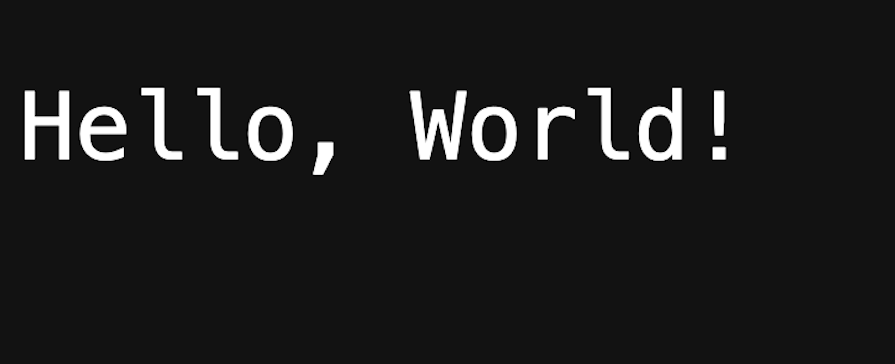
For the other GET route — the /greet/:name route — navigate to http://127.0.0.1:3000/greet/:name and replace :name with a name of your choice. As it’s just a URL parameter that responds with a personalized greeting, you should see something like this:
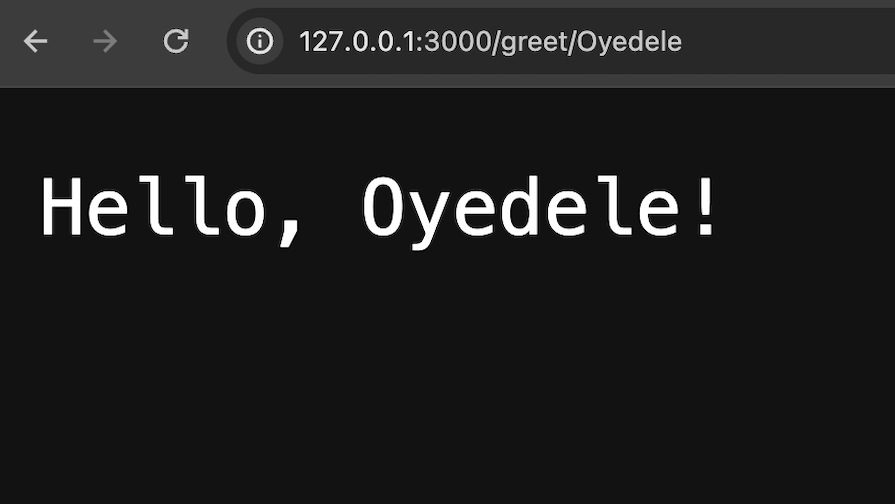
We’ll use Postman to test the POST route. If you’re using VS Code, you can download the Postman extension and sign in.
Create a new HTTP request. Set the request to type POST and also set the URL to this http://127.0.0.1:3000/submit. Next, navigate to the Body tab and select raw. Choose JSON from the dropdown menu. Enter the following JSON and click Send:
{
"name": "temitope",
"email": "[email protected]"
}
You’ll get a status 200 response like this:
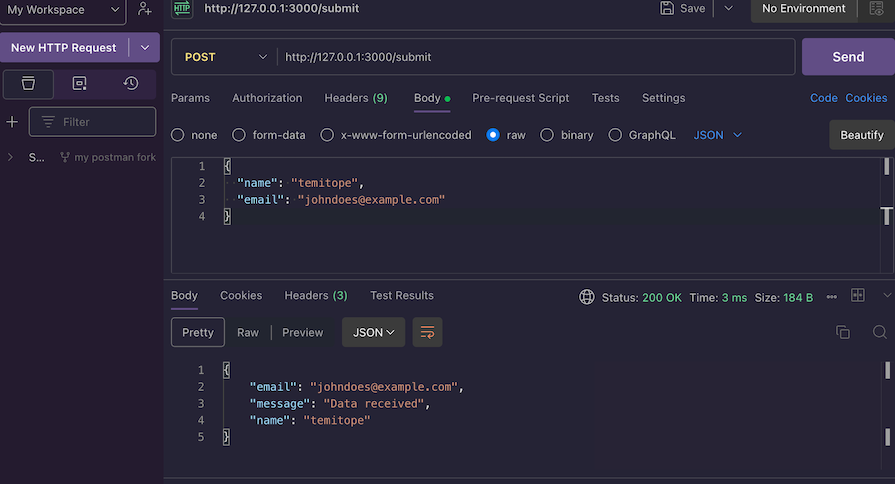
Gin is an HTTP web framework developed in Go. It’s often regarded as the most popular Go framework. Gin boasts of having a Martini-like API and claims to be up to 40 times faster than the Martini framework.
Besides Gin’s quickness, it’s also simple and straightforward to operate. Gin is a popular choice for developing restful APIs and services because it prioritizes performance and productivity.
Below are some crucial Gin features you should know:
HttpRouter package for routing, which provides fast routing and supports various routing methods and parametersLet’s use the Gin framework to build the same example as we did with Fiber. Open up the terminal and navigate to the folder for this project, then initialize your first module:
go mod init gin_demo
Install Gin into your project using the go get command:
go get -u github.com/gin-gonic/gin
This command installs the Go Gin package and its necessary dependencies.
We’ll create a simple example using the Gin framework in Go to demonstrate how to create a web server that responds to GET and POST requests. Create a file called main.go inside your project directory and add the following code:
package main
import (
"github.com/gin-gonic/gin"
)
func main() {
r := gin.Default()
r.GET("/", func(c *gin.Context) {
c.String(200, "Hello, World!")
})
r.GET("/greet/:name", func(c *gin.Context) {
name := c.Param("name")
c.String(200, "Hello, %s!", name)
})
r.POST("/submit", func(c *gin.Context) {
var json struct {
Name string `json:"name"`
Message string `json:"message"`
}
if err := c.ShouldBindJSON(&json); err != nil {
c.JSON(400, gin.H{"error": err.Error()})
return
}
c.JSON(200, gin.H{
"message": "Greeting received",
"name": json.Name,
"greeting": json.Message,
})
})
r.Run(":3000")
}
Run the command code using the go run command:
go run main.go
Navigate to http://127.0.0.1:3000/ in your browser, and you should see this:
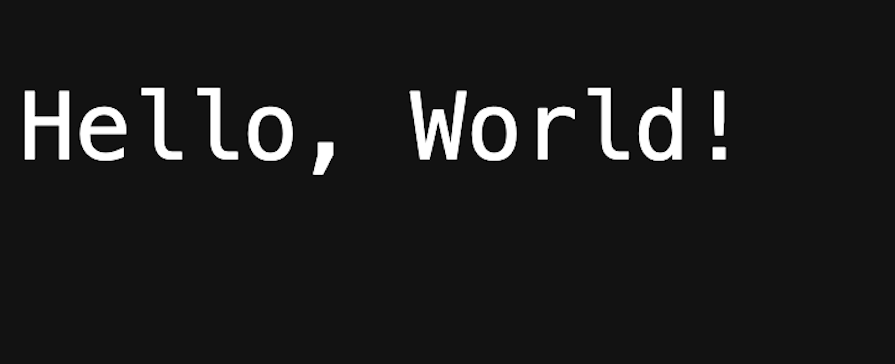
For the other GET route — the /greet/:name route — navigate to http://127.0.0.1:3000/greet/:name and, as before, replace the :name parameter with a name of your choice. You should see a customized message like this:

We’ll use Postman again to test the POST route. Create a new HTTP request, set the request to type POST, and then set the URL to this one: http://127.0.0.1:3000/submit.
Next, navigate to the Body tab and select raw. Choose JSON from the dropdown menu and enter the following JSON:
{
"name": "Temitope",
"message": "Good morning!"
}
You should have something like this:
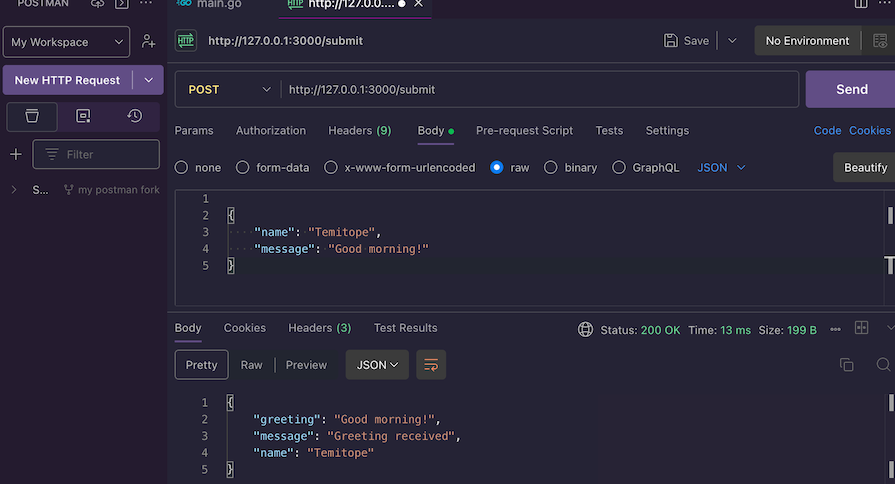
Now that we have a clear understanding of how both frameworks function, let’s compare them. This section will help you evaluate Fiber and Gin head-to-head so you can decide which one is the best fit for your needs.
The Go Fiber framework is simple and easy to use. It provides a minimal and intuitive API that is easy to learn and understand. Fiber provides you with a straightforward routing system and middleware support, which makes building and extending applications a smooth process.
Gin also has an intuitive API, making it easy to get started. Its routing system is flexible and powerful, allowing you to define routes with various methods and parameters. Gin’s middleware system is straightforward, and the framework provides helpful utilities for tasks like handling JSON and rendering responses.
Go Fiber utilizes the fasthttp library, which is known for its high-performance HTTP routing capabilities. As a result, Fiber is optimized for speed and can handle a large number of concurrent connections efficiently. It also has a lightweight memory footprint and is designed to minimize overhead, resulting in fast and responsive applications.
Gin is also designed with performance in mind. It uses the HttpRouter package to provide fast and efficient request routing. Gin is lightweight and efficient, with a minimal memory footprint. The framework is known for its speed and ability to handle high-traffic applications, with a routing system that’s optimized for performance to ensure fast response times.
Go Fiber is suitable for a variety of web applications, including high-load and high-performance projects. It’s an excellent solution for creating RESTful APIs, web services, and microservices. Fiber’s performance and efficiency make it an ideal choice for applications that require multiple concurrent connections, such as real-time chat or high-traffic websites.
Gin can also be used for a variety of web applications, from small to large-scale projects. It is especially well-suited to creating RESTful APIs and microservices. Gin’s lightweight and modular design makes it perfect for tasks that need flexibility. Its performance characteristics make it suitable for high-traffic applications and services that require efficient request handling.
Go Fiber has a growing developer and user base. With over 31k stars on GitHub, you can tell that it’s constantly updated and maintained by a devoted team of contributors. You can also raise issues, ask questions, and participate freely thanks to the supportive community.
Gin has a larger, more established community than Go Fiber, since it’s more widely adopted than Fiber. Gin has over 75,000 stars on GitHub and a strong developer community that contributes to and supports the framework.
Go Fiber takes a minimalistic and expressive development approach that prioritizes performance and efficiency. It provides a simple, versatile framework that offers a lightweight and fast solution for web development. Also, it’s intended to be intuitive and easy to use, minimizing the learning curve for developers.
Gin uses a modular and lightweight development approach. It provides a solid foundation that allows you to customize and enhance the framework according to your specific needs while using only the required packages. This design philosophy ensures that your apps remain lightweight, but are tailored to the project’s requirements.
Go Fiber provides easy routing, powerful middleware, built-in error handling, context locals, and support for WebSockets and HTTP/2.
Gin provides fast and flexible routing, modular middleware, JSON binding support, helper functions for rendering responses, custom logger, and integration with third-party packages.
Below is a table summarizing the comparison between Go Fiber and Gin:
| Criteria | Go Fiber | Gin |
|---|---|---|
| Ease of use | Minimal and intuitive API, easy to learn and use. | Simple and intuitive API with flexible routing and helpful utilities. |
| Performance | Built on fasthttp, optimized for speed and concurrent connections. | Utilizes HttpRouter for fast and efficient request routing. |
| Use case | Suitable for high-load and high-performance projects, RESTful APIs, and microservices. | Versatile, suitable for various projects, including RESTful APIs, microservices, and customization-heavy projects. |
| Community | Growing community with active contributions and support. | Larger, more established community with widespread adoption and third-party packages. |
| Development approach | Minimalistic and expressive, providing a simple and flexible framework. | Modular and lightweight, allowing customization and extension. |
| Features and tools | Easy routing, powerful middleware, built-in error handling, context locals, WebSockets, and HTTP/2 support. | Fast and flexible routing, modular middleware, JSON binding, response rendering helpers, custom logger, and third-party integrations. |
Both Go Fiber and Gin are great web frameworks for developing high-performance, efficient web applications in Go. Go Fiber stands out for its amazing performance, simplicity, and versatile middleware framework, making it an excellent solution for high-load and high-performance applications.
Gin, on the other hand, has a lightweight, modular design, a large middleware ecosystem, and built-in JSON binding support, making it ideal for a variety of projects that require flexibility and customization.
Consider your professional experience and project requirements to determine the choice between the two frameworks, use case, and preferred development approach.
Install LogRocket via npm or script tag. LogRocket.init() must be called client-side, not
server-side
$ npm i --save logrocket
// Code:
import LogRocket from 'logrocket';
LogRocket.init('app/id');
// Add to your HTML:
<script src="https://cdn.lr-ingest.com/LogRocket.min.js"></script>
<script>window.LogRocket && window.LogRocket.init('app/id');</script>

Container queries let components respond to their own layout context instead of the viewport. This article explores how they work and where they fit alongside media queries.

React Server Components vs Islands Architecture: Learn how each reduces client JavaScript, impacts hydration and interactivity, and which trade-offs matter for production performance.

Large hosted LLMs aren’t always an option. Learn how to build agentic AI with small, local models that preserve privacy and scale.

What storylines defined 2025 in frontend development? We power rank them all, from AI advancements to supply chain attacks and framework breakthroughs.
Would you be interested in joining LogRocket's developer community?
Join LogRocket’s Content Advisory Board. You’ll help inform the type of content we create and get access to exclusive meetups, social accreditation, and swag.
Sign up now